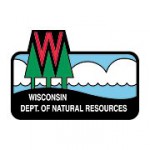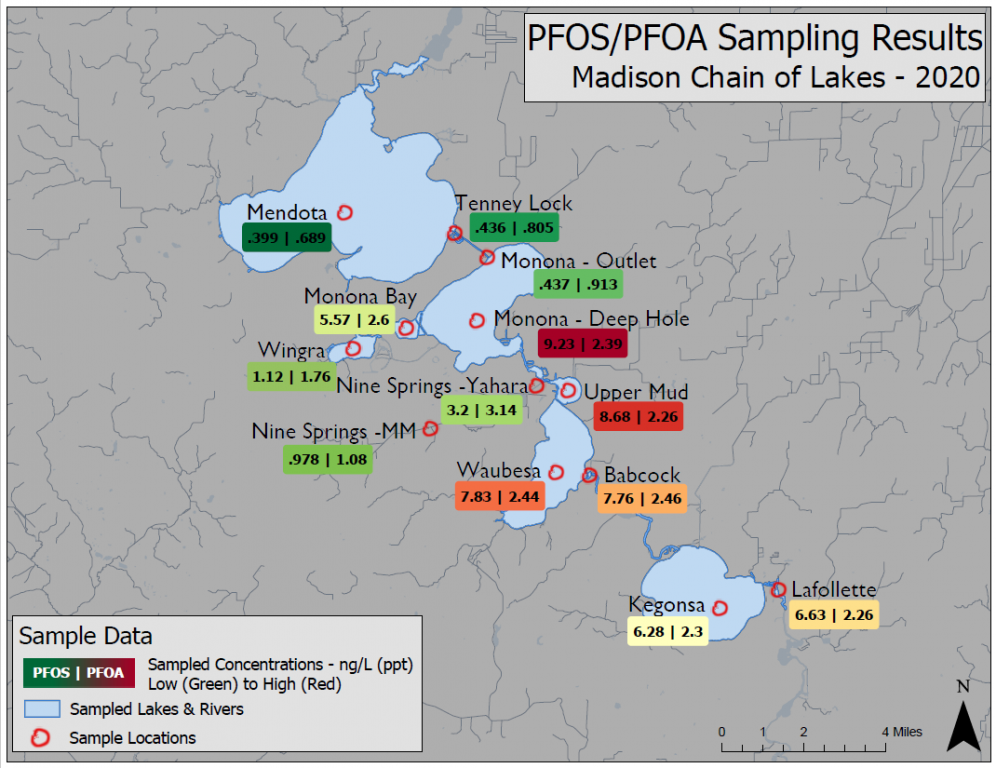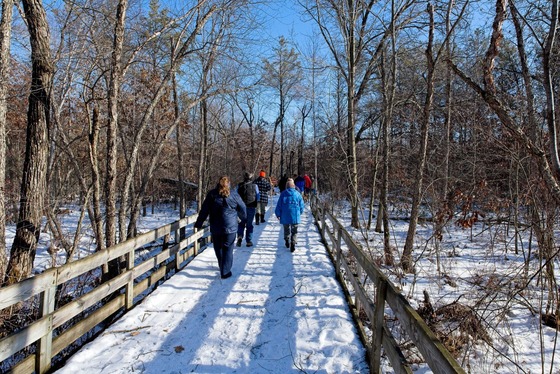DNR Releases Latest Sampling Results Revealing Broader PFAS Presence In Madison Area Lakes And Yahara River Chain
MADISON, Wis. – The Wisconsin Department of Natural Resources (DNR) today announced the presence of elevated levels of per- and polyfluoroalkyl substances (PFAS) in surface water samples taken from Madison-area lakes and along the Yahara River.
The DNR found elevated levels of PFAS in Lake Monona and Starkweather Creek in 2019, which resulted in a new PFAS fish consumption advisory for those two water bodies. The DNR collected surface water and fish samples in 2019 due to PFAS-containing stormwater leaving the Dane County airport into Starkweather Creek and Lake Monona.
The DNR also collected samples from Lake Wingra and Nine Springs Creek. PFAS compounds were discovered throughout the areas sampled, many of those samples were at levels above what the DNR may consider acceptable.
PFAS are a group of human-made chemicals used for decades in numerous products, including non-stick cookware, fast food wrappers and stain-resistant sprays. These legacy contaminants have made their way into the environment in a variety of ways, including spills of PFAS-containing materials, discharges of PFAS-containing wastewater to treatment plants and certain types of firefighting foams.
PFAS do not break down in the environment and have been discovered at concentrations of concern in groundwater, surface water and drinking water. PFAS are known to bioaccumulate in the tissues of fish and wildlife. They also accumulate in the human body and pose several risks to human health.
Surface Water Sampling
Lake Mendota was found to have values below 1.0 parts-per-trillion (ppt) for the PFAS compounds PFOS and PFOA. However, Lake Monona had values as high as 9.2 ppt PFOS and 2.4 ppt PFOA. Values for Upper Mud were 8.7 ppt PFOS and 2.3 ppt PFOA. Waubesa had levels of 7.8 ppt PFOS and 2.4 ppt PFOA, and Kegonsa 6.2 PFOS and 2.3 ppt PFOA.
Samples taken in 2020 were analyzed for 36 PFAS compounds, including PFOS and PFOA, at the Wisconsin State Lab of Hygiene.
The 2019 samples showed 10 ppt to 12 ppt for PFOS and less than 3 ppt for PFOA. The DNR’s 2019 sampling of Starkweather Creek began following results of sampling completed at the Dane County Airport that showed elevated levels of PFAS. The stormwater system at the airport discharges to Starkweather Creek which ultimately enters Lake Monona near Olbrich Park. PFAS contamination was found in Starkweather Creek from its headwaters northeast and east of the airport, through its length to where it discharges into Lake Monona. PFOS concentrations ranged from less than 1 ppt to 3700 ppt.
There are known discharges of PFAS compounds to soil, surface water and groundwater on the airport property likely stemming from multiple responsible parties. The DNR has regulatory oversight in cases where there has been a discharge of a hazardous substance to the environment. The DNR is actively working with responsible parties to discuss next steps.
2020 Fish Tissue Sampling
The DNR continues to conduct comprehensive fish contaminant monitoring on the Yahara chain of lakes, targeting a variety of species for PFAS and other contaminants. Due to the time required to process and analyze fish tissue samples, the DNR expects the results of this testing are expected in Spring 2021.
More information on how the DNR is addressing PFAS contamination in Wisconsin is available here.
NOTE: This press release was submitted to Urban Milwaukee and was not written by an Urban Milwaukee writer. While it is believed to be reliable, Urban Milwaukee does not guarantee its accuracy or completeness.
More about the PFAS Problem
- Bipartisan Push to Tell Counties Faster When Water Tests Fail - Henry Redman - Dec 19th, 2025
- MKE County: County Seeks to Sue PFAS Producers, Oil Companies - Graham Kilmer - Dec 10th, 2025
- Wisconsin Reviewing EPA-Approved Pesticides For PFAS - Danielle Kaeding - Dec 9th, 2025
- State Nears Settlement with Johnson Controls/Tyco Over PFAS Spills - Danielle Kaeding - Dec 4th, 2025
- Senate Bill Promotes Soybean-Based Firefighting Foam to Replace PFAS - Danielle Kaeding - Dec 2nd, 2025
- Test Results Show High PFAS Levels in Wisconsin’s Landfill Runoff - Danielle Kaeding - Dec 2nd, 2025
- Wisconsin Communities Get $282 Million for Drinking Water Projects - Danielle Kaeding - Nov 19th, 2025
- Gov. Evers, DNR Announce $282 Million to Improve Drinking Water Quality for Wisconsinites in 74 Municipalities - Gov. Tony Evers - Nov 18th, 2025
- Cleanup of PFAS Could Cost Wisconsin Billions - Danielle Kaeding - Nov 13th, 2025
- Cleanup PFAS Without Penalizing Innocent Landowners - Wisconsin Manufacturers & Commerce - Nov 4th, 2025
Read more about PFAS Problem here
Mentioned in This Press Release
Recent Press Releases by Wisconsin Department of Natural Resources
DNR Confirms CWD in Wild Deer in La Crosse County
Dec 22nd, 2025 by Wisconsin Department of Natural ResourcesBaiting And Feeding Ban Extended




















